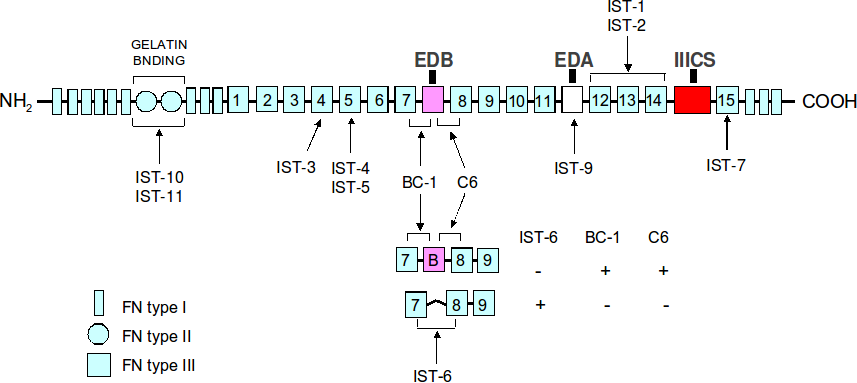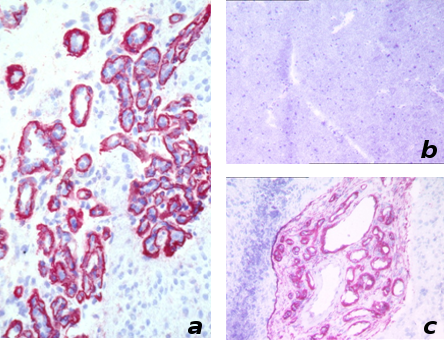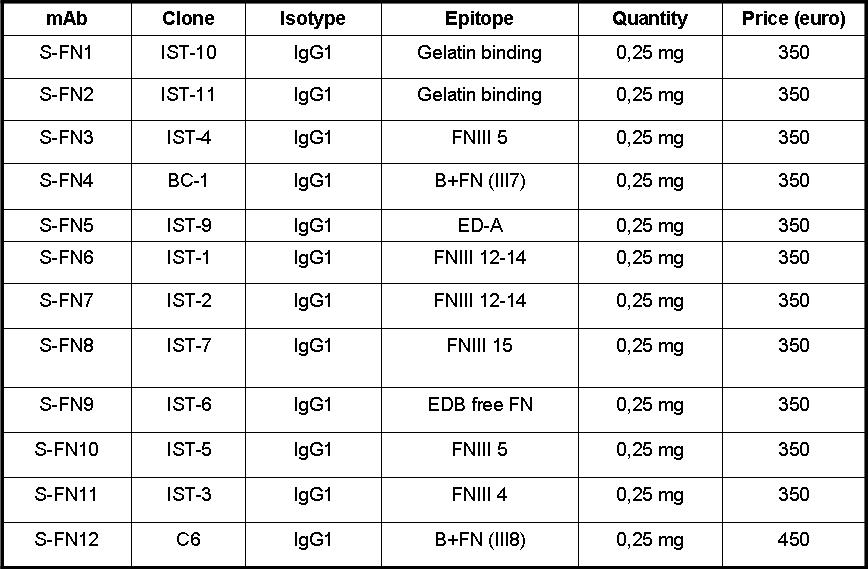Overview
Sirius-biotech offers the following services and products:
- NEW!! Antibody to periostin
- Custom antibodies
- Antibodies to tenascin-C
- Antibodies to fibronectin
- B-FN a marker of angiogenesis
- ED-A of FN
Custom antibodies
- Antigen preparation
- Custom monoclonal and polyclonal antibody production
- Variable region cloning and sequencing
- Monoclonal antibodies purification and characterization
- Immunohistochemistry service on frozen normal and neoplastic human tissues
- In vivo biodistribution
Antibody to periostin
Periostin is an extracellular matrix protein and is a member of the fasciclin family of proteins. It is involved in cell survival, angiogenesis, invasion and metastasis. It is considered a marker of tumor progression in many types of human cancers.
The monoclonal antibody OC-20 reacts with the FAS1-2 domain of periostin. The epitope recognized by OC-20 is a new cell binding site for the integrins αvβ3 and αvβ5. In vivo in tumor-bearing mice, OC-20 shows inhibitory activity of angiogenesis and tumor growth.
References
- The multifacted role of periostin in tumorigenesis. Ruan K, Bao S, Ouyang G. Cell Mol Life Sci. 2009;66:2219-30
- Identification of a novel cell binding site of periostin involved in tumor growth. Orecchia P, Conte R, Balza E, Castellani P, Borsi L, Zardi L, Mingari MC, Carnemolla B. Eur J Cancer 2011;47:2221-9.
Antibodies to tenascin-C
Antibodies to fibronectin

B-FN a marker of angiogenesis from Sirius-biotech
Sirius- biotech offers BC-1 mAb specific for the angiogenesis associated B-FN as well as a large panel of antibodies for different epitopes of human fibronectin.
More info on this topic is also available.

Human glioblastoma stained with the mAb BC1 (a). A zoom view is shown in (c). In (b), normal brain stained with the mAb BC-1 is shown
ED-A of FN
ED-A promotes cell spreading interacting with the integrin alpha5-beta1, alpha4-beta1 and alpha9-beta1. Sirius-biotech offers the monoclonal IST-9 that inhibits cell adesion to these integrins reacting wit the C-C’ loop of ED-A. Furthemore the mab IST-9 inhibits the differentiation of fibroblasts into myo-fibroblasts and TGF-beta activation, thus inhibiting fibrosis.
References
-
Monoclonal antibodies in the analysis of fibronectin isoforms generated by alternative splicing of mRNA precursors in normal and transformed human cells.. Borsi L., Carnemolla B., Castellani P., Rosellini C., Vecchio D., Allemanni G., Chang S.E.,Taylor Papadimitriou J., Pande H. and Zardi L. J. Cell Biol. 1987;104:595-600.
-
Localization of the cellular-fibronectin-specific epitope recognized by the monoclonal antibody IST-9 using fusion proteins expressed in E. coli. Carnemolla B., Borsi L., Zardi L., Owens R.J. and Baralle F. FEBS L. 1987;215 :269-73.
-
The Fibronectin Domain ED-A is Crucial for Myofibroblastic Phenotype Induction by Transforming Growth Factor-beta1. Serini G., Bochaton-Piallat M.L., Ropraz P., Geinoz A., Borsi L., Zardi L. and Gabbiani G. J. Cell Biol. 1998;142(3):873-881
-
An essential role for fibronectin extra type III domain A in pulmonary fibrosis. Muro AF, Moretti FA, Moore BB, an M, Atrasz RG, Wilke CA,,et al.
-
Am J Respir Crit Care Med. 2008 ,177:638-45.
-
Prothrombotic effects of fibronectin isoforms containingthe EDA domain.Chauhan AK, Kisucka J, Cozzi MR, Walsh MT, Moretti FA, Battiston M, Mazzucato M, De Marco L, Baralle FE, Wagner DD, Muro AF.Arterioscler Thromb Vasc Biol. 2008;28296-301.
-
Identification of two amino acids within the EIIIA (ED-A) segment of fibronectin constituting the epitope for two function-blocking monoclonal antibodies. Liao YF, Wieder KG, Classen JM, Van De Water L.J Biol Chem. 1999;274:17876-84.



